Collections
The permanent collection at the Forbes House Museum comprises three important components: Chinese export porcelain, silver, paintings, and furniture; Civil War and President Lincoln memorabilia; and Forbes family holdings, including American and European painting, furniture, and artifacts.
Chinese Export Art
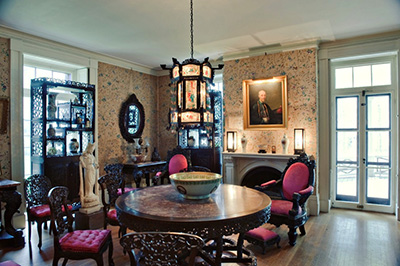 As merchants in the China Trade, the Forbes men returned from their voyages to Canton, China (now Guangzhou), with beautiful examples of export works of art.
As merchants in the China Trade, the Forbes men returned from their voyages to Canton, China (now Guangzhou), with beautiful examples of export works of art.
The collection includes impressive and often rare examples of export porcelain on which hand-painted images of nature appear, including dragons, monkeys, horses, birds, insects, flowers, and people at tea or engaged in other domestic activities. Some items were made especially for the American market, including tea cups adorned with a bald eagle. Of particular interest is the Forbes Election Bowl, an elegant and luminous 19th-century Chinese porcelain object decorated with bands of Scottish thistle and ivy, the Forbes family crest and two Scottish castles.
Gracing the Chinese Parlor is a dining set of Cantonese marble and hand-carved rosewood, brought back from China in the mid-1800s by Captain Forbes. At center, a lantern depicting peacocks, fruit, and finely dressed ancestors is perched above the table. In Chinese culture, one honors his/her ancestors by living a good and healthy life; the peacock is the symbol of good or healthy living. There is a portrait of Houqua (Wu Ping-chien) (1769–1843), painted by the Chinese artist, Lamqua (Kwan Kiu-cheong) (1801–1860), whose instructor was the English-born artist, George Chinnery (1774–1852). Visitors can also see Guan Yin, the Buddhist goddess of mercy, and a bronze Buddha, along with hand-painted silk wall paper recreated from remnants found beneath the door moldings.
The Civil War and President Lincoln Collection
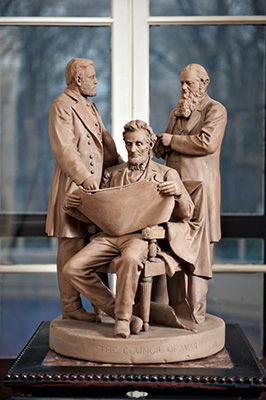 Captain Robert Bennet Forbes and his brother, John Murray Forbes, supported the Union cause during the Civil War. Under the Captain’s order or supervision, several vessels were built for service during the war, including the gunboats Sagamore, Huron, Chocorua, and Kineo. The brothers were founding members of the Union Club in Boston and supporters of the African American infantry, the 54th Regiment Massachusetts Volunteer Infantry Company A.
Captain Robert Bennet Forbes and his brother, John Murray Forbes, supported the Union cause during the Civil War. Under the Captain’s order or supervision, several vessels were built for service during the war, including the gunboats Sagamore, Huron, Chocorua, and Kineo. The brothers were founding members of the Union Club in Boston and supporters of the African American infantry, the 54th Regiment Massachusetts Volunteer Infantry Company A.
It is no surprise, therefore, that the Captain’s granddaughter, Mary Bowditch Forbes (1878 – 1962), began collecting Civil War and President Lincoln memorabilia. In 1909, she acquired a commemorative penny, released by the U. S. Treasury, in honor of the centenary of our 16th president’s birth.
Similarly, other commemorative items were made available to collectors, including this sculpture, “The Council of War,” depicting a seated President Lincoln flanked by Secretary of War Edwin M. Stanton, at right, and General Ulysses S. Grant.
The Civil War and President Lincoln Collection includes a series of prints by Currier & Ives depicting the important battles of Antietam, Gettysburg, and Cold Harbor, and an oil painting of the battle of iron-hulled warships Merrimack and Monitor. The Museum owns a Union cavalry officer’s sword and a Civil War era ensign flag featuring only thirteen stars. Ms. Forbes acquired memorabilia from the Wide Awake Party and the Grand Army of the Republic. The collection includes a campaign banner from 1860, which was used at a rally in Dorchester, Massachusetts, for then-candidate Lincoln (who visited and stayed overnight at a house not far from the FHM). Over a span of forty years, Mary Bowditch Forbes filled seven large scrapbooks with newspaper clippings and photographs; these are regularly put on display in the Museum’s Lincoln Room.
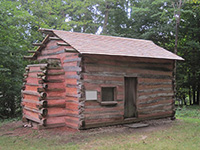 In 1924, Ms. Bowditch Forbes had a replica of Lincoln’s birthplace built on the grounds of the estate and began the annual tradition of celebrating Lincoln Day, on which veterans, political leaders, celebrities (on occasion), and local citizens assembled to hear speeches. Today, visitors can still see the Lincoln Cabin during their visit to FHM, and they are invited to join the Lincoln Day festivities traditionally held in the spring.
In 1924, Ms. Bowditch Forbes had a replica of Lincoln’s birthplace built on the grounds of the estate and began the annual tradition of celebrating Lincoln Day, on which veterans, political leaders, celebrities (on occasion), and local citizens assembled to hear speeches. Today, visitors can still see the Lincoln Cabin during their visit to FHM, and they are invited to join the Lincoln Day festivities traditionally held in the spring.
The Forbes Family Collection
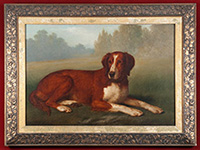 The Museum’s collection includes objects, paintings, and furniture owned by four generations of the Forbes family. In the library of James Murray Forbes (1845–1937), the Captain’s son, visitors can view two oil paintings by Milton-born artist Thomas Hewes Hinckley (1813–1896), an internationally known painter of domestic animals and wildlife. Hinckley, who was also a sailor and merchant, set up an artist’s studio in Milton in 1833, the same year that the Forbes House was built. He received a commission from James Murray Forbes in 1884 to paint a portrait of Captain Forbes’ favorite dog, Phil, which hangs in the library today.
The Museum’s collection includes objects, paintings, and furniture owned by four generations of the Forbes family. In the library of James Murray Forbes (1845–1937), the Captain’s son, visitors can view two oil paintings by Milton-born artist Thomas Hewes Hinckley (1813–1896), an internationally known painter of domestic animals and wildlife. Hinckley, who was also a sailor and merchant, set up an artist’s studio in Milton in 1833, the same year that the Forbes House was built. He received a commission from James Murray Forbes in 1884 to paint a portrait of Captain Forbes’ favorite dog, Phil, which hangs in the library today.
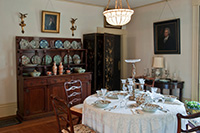 The dining room features mahogany pierced ladder-back Chippendale-style chairs and a Hudson River Valley sideboard containing export porcelain patterns, including Rose Medallion, Celadon, and Orange Fitzhugh. On the wall at left, hangs a portrait of Ralph Bennet Forbes, the Captain’s father, and at right, John Murray Forbes, the Captain’s uncle, a diplomat and United States ambassador. In the background, a 19th-century Chinese lacquered screen, one of many at the FHM, can be seen.
The dining room features mahogany pierced ladder-back Chippendale-style chairs and a Hudson River Valley sideboard containing export porcelain patterns, including Rose Medallion, Celadon, and Orange Fitzhugh. On the wall at left, hangs a portrait of Ralph Bennet Forbes, the Captain’s father, and at right, John Murray Forbes, the Captain’s uncle, a diplomat and United States ambassador. In the background, a 19th-century Chinese lacquered screen, one of many at the FHM, can be seen.
In the winter of 1847, citizens of Boston, among them Captain Forbes and his brother, John Murray Forbes, organized a humanitarian relief effort for Ireland during the Great Famine. Eight hundred tons of food and other provisions were transported to Cork, Ireland, by Captain Forbes aboard the Navy’s USS Jamestown. In a gesture of gratitude, the wheel of the ship was given to the Captain, and is on display in the Museum along with the travel trunk he used on his first voyage to Canton, China, in 1817.
Upstairs Downstairs: Irish Workers and the 1870s Kitchen
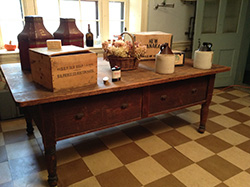 The ground floor of the Museum features an 1870s kitchen with an iron stove, ice box, bell system for calling servants, and a 100-year-old box of S.S. Pierce soap with 20 original bars inside. Cooking and washing laundry were done on the ground level by domestic workers, all of whom were immigrants from Ireland (except for one Swedish woman). The Forbes family also employed chauffeurs, groundskeepers and caretakers of horses, goats, and dogs. At the height of activity on the property—after 1870 when James Murray Forbes and his family resided there more frequently—ten to twelve paid servants worked on the premises.
The ground floor of the Museum features an 1870s kitchen with an iron stove, ice box, bell system for calling servants, and a 100-year-old box of S.S. Pierce soap with 20 original bars inside. Cooking and washing laundry were done on the ground level by domestic workers, all of whom were immigrants from Ireland (except for one Swedish woman). The Forbes family also employed chauffeurs, groundskeepers and caretakers of horses, goats, and dogs. At the height of activity on the property—after 1870 when James Murray Forbes and his family resided there more frequently—ten to twelve paid servants worked on the premises.
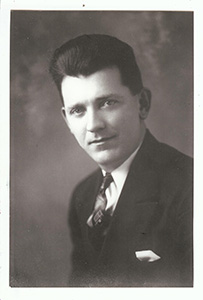 The Museum has researched the lives of Irish workers and conducted several oral history interviews with their children and grandchildren. From 1833 to 2000, 41 people worked (and sometimes also lived) at Forbes House. Among them was Michael Burke, who was employed by the Forbes family for 76 years, even after the mansion was converted into a museum. Burke emigrated from County Galway, Ireland, in 1924 at the age of eighteen.
The Museum has researched the lives of Irish workers and conducted several oral history interviews with their children and grandchildren. From 1833 to 2000, 41 people worked (and sometimes also lived) at Forbes House. Among them was Michael Burke, who was employed by the Forbes family for 76 years, even after the mansion was converted into a museum. Burke emigrated from County Galway, Ireland, in 1924 at the age of eighteen.